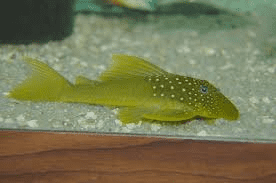
Common name: Green Phantom Plecostomus, L200
Scientific name: Hemiancistrus Subviridis, L200
Average Adult Fish Size: 7 inches / 18 cm
Place of Origin: Rio Orinoco, Venezuela
Typical Tank setup: Rocky S. American biotope with a lot of caves and hiding places. Driftwood or bogwood is considered unnecessary by some, and a requirement by others. It can’t hurt, so it should be included to be safe.
Recommended Minimum Aquarium Capacity: 30 gallon / 120 litre
Compatibility: Peaceful if given enough hiding places to call its’ own.
Temperature: 72 – 77 Deg F / 22 – 25 Deg C
Water chemistry: pH 6.0 – 7.2
Feeding: Though it is an effective algae eater it should be considered omnivorous and fed a balanced staple diet of wafers, sticks, and pellets along with frozen foods such as brine shrimp and blood worms.
Sexing: Venting is the best way to sex this fish, although mature males usually develop thick odontodes on the cheeks and pectoral fins.
Breeding: This cave-spawning species has been bred in the home aquarium. Provide a selection of narrow caves constructed from the rockwork or use PVC pipes/clay breeding tubes. The female will lay between 30 and 40 large yellow eggs inside the cave, which the male fertilises and subsequently guards; the female takes no further part in parental care. Expect the eggs to hatch within 3-5 days (temperature dependent). The fry will gain nutrition by absorbing their yolk sacs for the first week or so, and after that will require appropriately sized sinking foods. It is important that high water quality is maintained at all times. As the fry can be sensitive to bacteria amongst the substrate, do ensure that no food is left to rot on the bottom.
Additional Information: The Green Phantom Pleco is a stunning bright green-yellow suckermouth catfish, suitable for large, mature softwater aquaria. In the wild, they are found in the cracks/interstices between granite rocks amongst fast flowing waters.


Related Posts
Croaking Gourami – Trichopsis vittatus
Paradise Fish – Macropodus opercularis
Schubert’s Barb – Barbus Semifasciolatus